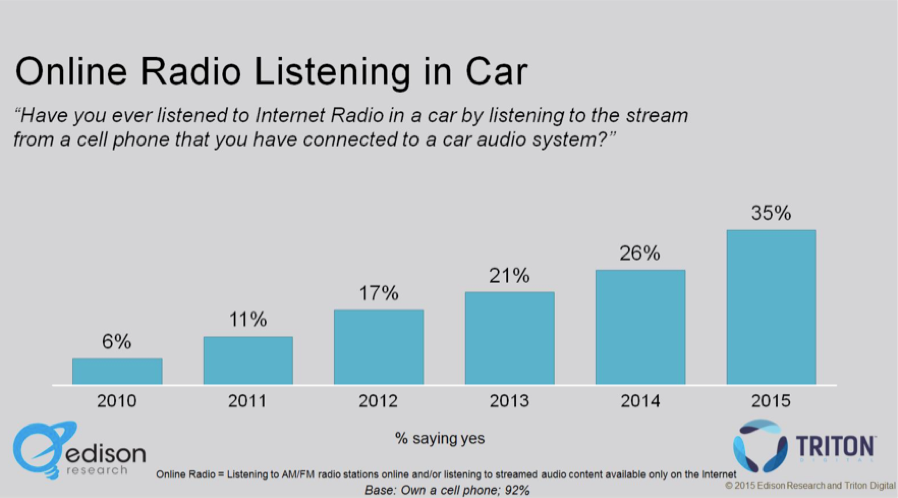It’s all about connectivity to the car audio system. Since 2010, Edison Research has been asking the question of consumers, “Have you ever listened to Internet radio in a car by listening to the stream from a cell phone that you have connected to a car audio system?” The number grew by 9% from 26% to 35% between 2014 and 2015. The question to consider: what is the limiting factor in responses? Does this question measure consumer interest or is it a proxy for availability of Bluetooth and other connectivity in the car?

As Edmunds.com put it in 2013:
Bluetooth began as a feature found only in high-end cars, introduced as a way to make hands-free phone calls behind the wheel. The auto industry standard for wirelessly connecting portable devices has since become a prevalent feature in most new vehicles. As smartphones become the preferred method for delivering Internet-based content to car infotainment systems, Bluetooth provides the nearly indispensable link.
In-Car Internet Radio Use Aligning with Connectivity
Bluetooth was first introduced into cars in 2001, but it wasn’t quick to catch on and for years remained a feature limited to high-end models for hands-free calling. That all changed with the rise of smartphones, new audio consumption habits, and state ordinances outlawing all but hands-free cell phone conversations. Once Bluetooth entered the car for calling and the higher fidelity A2DP standard was adopted, consumers started using it for audio content as well. It’s hard to find a new car model today that does not have Bluetooth connectivity and the even more robust connected car features are becoming commonplace. However, 11.4 years ago, the opposite was true.
How Bluetooth Explains the Growth of In-Car Internet Radio
 This brings us back to the Edison Research finding of an increase of 9% of the population having listened to Internet radio in the car in 2014. Let’s look at the math. Automotive industry analyst IHS reports the average age of a passenger vehicle in the U.S. is 11.4 years. This would assume the replacement of the entire U.S automotive fleet every 11.4 years which translates into 8.77% annually. If you review Department of Transportation statistics on passenger vehicles and short wheelbase trucks from 2012 and account for population growth through last year, the 16.5 million new vehicles sold in 2014 represents 8.88% of the total fleet.
This brings us back to the Edison Research finding of an increase of 9% of the population having listened to Internet radio in the car in 2014. Let’s look at the math. Automotive industry analyst IHS reports the average age of a passenger vehicle in the U.S. is 11.4 years. This would assume the replacement of the entire U.S automotive fleet every 11.4 years which translates into 8.77% annually. If you review Department of Transportation statistics on passenger vehicles and short wheelbase trucks from 2012 and account for population growth through last year, the 16.5 million new vehicles sold in 2014 represents 8.88% of the total fleet.
We see in these statistics a convergence on the 9% number for new cars sold and new listeners to in-car Internet radio. The fact is that most of the older cars being replaced by new purchases did not have Bluetooth, much less a connected car system, but new automobiles do. A logical conclusion is that new car owners are often trying Bluetooth for the first time and they are invariably using it for both hands-free calling and audio content consumption. If over 50% of the U.S. population listens to Internet radio monthly, why have only 35% listened in the car? The limiting factor has likely been lack of Bluetooth connectivity in their primary vehicle.
Another Big Jump in 2015 and a Threat to Broadcast Radio
Not every new car has Bluetooth, even though a large majority does today. However, that contention suggests Internet radio listening in-car actually outperforms the growth in access to easy in-car connectivity through Bluetooth. The implication for Internet radio is that this number should jump significantly each of the next few years as another 16 million new vehicles hit the road annually. Growth for in-car Internet radio listening either through Bluetooth or a connected car dashboard is inevitable and is artificially constrained today by the preponderance of older vehicles on the highways.
The other implication is for broadcast radio which relies on the car for 42% of its listening. As more consumers have access to Internet radio through their in-car audio systems, broadcast radio will have to compete more for listener attention.
Related Posts
Audio in the Car – Streaming, Voice and Interaction
Amazon, Ford and More Use Interactive Audio Ads in 2014
Internet Radio Trends Report 2015
